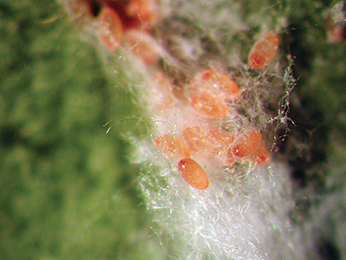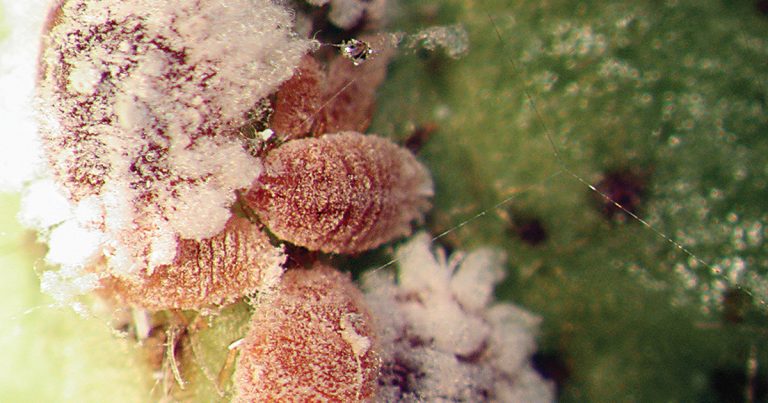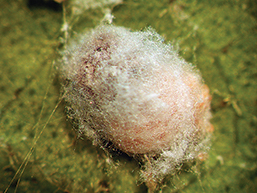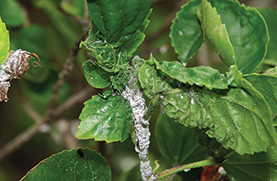Free printed copies of pest alerts are available.
Origin and Distribution
The pink hibiscus mealybug (PHM), thought to be native to southern Asia, is a serious pest of numerous host plants in many tropical and subtropical climates. The distribution of PHM has subsequently spread to Africa, Australia as well as areas within North, Central, and South America. In the United States, PHM was first detected in Hawaii in 1984, California in 1999, and Florida in 2002. Biological control efforts have been successfully implemented for all of these populations, which have shown significant impact on reducing this mealybug’s population density, however populations have persisted and PHM continues to be found in new areas. States that are considered climatically suitable for pink hibiscus mealybug are Alabama, Arizona, Arkansas, California, Florida, Georgia, Hawaii, Louisiana, Mississippi, Oklahoma, Nevada, New Mexico, North Carolina, South Carolina, Tennessee, Texas, Utah, and Virginia based on comparing climates of infested regions around the world.
Host Range
The broad host range of PHM allows for rapid spread of the insect once introduced into an area, but the most commonly encountered host plant material in Florida includes hibiscus, Florida trema, and senna. PHM is know to infest more than 300 plant species.
Description of PHM
Female adult PHM are approximately 3 mm in length (1/10 inches), wingless, and have piercing–sucking mouthparts. A white cotton-like wax covers the female’s reddish body. When punctured, the female’s body fluids are also reddish, but it is important to note that some other mealybug species may have a similar coloration. PHM egg masses are pinkish. Newly emerged first instars or crawlers are pink. Nymphs of both sexes resemble smaller versions of mature adult females. The male pupal stage is a sessile cocoon made of mealy wax. The reddish brown adult male PHM are slightly smaller than the female; has one pair of wings; and two long, waxy tails (caudal filaments). Because the adult males have nonfunctioning mouthparts and only live for a couple of days, the adult male is not as commonly observed in the field around plant material.
Life Cycle
Adult female PHM has five life stages: egg, first instar (crawler), second instar (nymph), third instar (nymph), and fourth instar (adult). Adult male PHM has six life stages: egg, first instar (crawler), second instar (nymph), third instar (prepupal), fourth instar (pupal), and fifth instar (adult). Dispersal primarily occurs in the crawler and nymphal stages through walking, wind, or hitchhiking on animal or plant material. Unmated females produce a sex pheromone to attract males. After mating, females secrete an irregular-shaped white cotton-like egg mass that contains 300 to 600 eggs that turn pink as they mature. First instars (crawlers) are pink and emerge from the eggs. In tropical climates, PHM remains active year-round and may produce up to 15 generations per year. In cooler climates, PHM overwinters in the egg or adult female stage in bark crevices, soil, tree holes, fruit, and crumpled leaf clusters.



Plant Symptoms and Monitoring
Heavy white, cotton-like, waxy buildup on branches and stems of host plants may indicate PHM infestations. Female PHM injects toxic saliva while feeding on fluids from many plant species, resulting in leaf curling similar to damage caused by viruses. Heavily infested plants are stunted, fruits may be deformed, and shoot tips may develop a bushy appearance commonly referred to as “bunchy top.” Black sooty mold may develop on infested plant leaves as a result of PMH honeydew excretions. Extremely high populations of PMH can kill plants.
If you suspect trees or plants are infested with PHM, contact your state’s university diagnostic laboratory or Department of Agriculture diagnostic laboratory immediately (contact university extension personnel for the address of the diagnostic laboratory). Field identification is not definitive. Several other mealybugs may resemble PHM in the field. PHM samples for all new state or county records should be submitted for species-level confirmation.

Biological Control
The use of natural enemies has been shown to reduce PHM populations. In California, Florida, and Hawaii the release of two parasitic wasps, Anagyrus kamali Moursi and Gyranusoidea indica Shafee, Alam & Agarwal (Hymenoptera: Entricidae) reduced and maintained PHM populations below economically damaging levels. The predaceous lady beetle Cryptolaemus montrouzieri Mulsant is a voracious feeder on PHM and has been effectively used to control limited PHM infestations alone, but adults are known to disperse when PHM populations drop to low levels. This behavior allows PHM to increase its population densities above levels that are normally self-sustained by parasites alone. The larval stage of the beetle may be mistaken for large mealybugs due to their heavy wax coating, similar to PHM.
Management
Because PHM is a regulated organism, management, destruction, and disposal protocols are coordinated by state regulatory officials. If diagnosticians confirm PHM infestation of plants at nurseries or other commercial landscape facilities, quarantine measures will be implemented per state protocols. Due to a zero tolerance standard for PHM in nursery stock, the destruction of infested plant material and the application of prescribed chemicals may be recommended. Homeowners should contact their local cooperative extension service for questions about suspect PHM-infested plants. Each state’s local cooperative extension service, state department of agriculture, and APHIS-associated personnel will determine if a biological control release is appropriate.
If you suspect you have a pink hibiscus mealybug please contact your states National Plant Diagnostic Network laboratory: npdn.org
Credits
Editor: Julie Todd, Technically Correct Scientific Communications, State College, PA.
Graphic designer: Gretchen Wieshuber, Studio 2D
Photos: courtesy of Lance Osborne, University of Florida
Reviewers:
Amanda Hodges, University of Florida
Karolynne Griffiths, USDA–APHIS–PPQ
Dale Meyerdirk, USDA–APHIS–PPQ
Lance Osborne, University of Florida
This work is supported by the Crop Protection and Pest Management Program (2018-70006-28884) from the USDA National Institute of Food and Agriculture.
For information about the Pest Alert program, please contact the North Central IPM Center at northcentral@ncipmc.org.
June 2019

